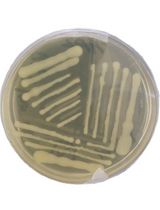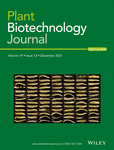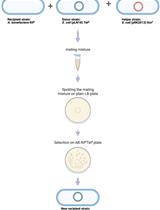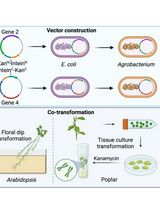- EN - English
- CN - 中文
Transformation and Detection of Soybean Hairy Roots
大豆毛状根的转化与检测
(*contributed equally to this work) 发布: 2023年06月05日第13卷第11期 DOI: 10.21769/BioProtoc.4691 浏览次数: 1852
评审: Zhibing LaiAli ParsaeimehrRaviraj Mahadeo Kalunke

相关实验方案

将Miniprep制备的大肠杆菌K12菌株质粒DNA转化为可用于植物遗传转化的根癌农杆菌EHA105细胞的简单可靠方法
Beenzu Siamalube [...] Steven Runo
2025年01月05日 1458 阅读
Abstract
Agrobacterium rhizogenes is a soil bacteria with extensive infectivity, which can infect almost all dicotyledonous plants and a few monocotyledonous plants to induce root nodules. This is caused by the root-inducing plasmid, which contains genes responsible for the autonomous growth of root nodules and crown gall base synthesis. Structurally, it is similar to the tumor-inducing plasmid in that it mainly contains the Vir region, the T-DNA region, and the functional region of crown gall base synthesis. Its T-DNA is integrated into the nuclear genome of the plant with the assistance of Vir genes, causing hairy root disease in the host plant and the formation of hairy roots. The roots produced by Agrobacterium rhizogenes–infested plants are characterized by a fast growth rate, high degree of differentiation, physiological, biochemical, and genetic stability, and ease of manipulation and control. In particular, the hairy root system is an efficient and rapid research tool for plants that have no affinity for transformation by Agrobacterium rhizogenes and low transformation efficiency. The establishment of germinating root culture system for the production of secondary metabolites in the original plants through the genetic transformation of natural plants mediated by root-inducing plasmid in Agrobacterium rhizogenes has become a new technology combining plant genetic engineering and cell engineering. It has been widely used in a variety of plants for different molecular purposes, such as pathological analysis, gene function verification, and secondary metabolite research. Chimeric plants obtained by induction of Agrobacterium rhizogenes that can be expressed instantaneously and contemporarily are more rapidly obtained, compared to tissue culture and stably inheritable transgenic strains. In general, transgenic plants can be obtained in approximately one month.
Keywords: Agrobacterium rhizogenes (发根农杆菌)Background
The methods for soybean genetic transformation can be roughly divided into two types, with different applications: (1) Agrobacterium-mediated transformation, and (2) foreign target genes being introduced into the recipient soybean cells by auxiliary means, such as instruments (gene guns) or reagents (cell wall enzymes). This second type includes the microinjection, pollen tube channel, electroporation (Zhou and Qiu, 2010), polyethylene glycol (Liu and Friesen, 2012), and gene gun methods.
Agrobacterium rhizogenes–mediated genetic transformation is a new plant tissue culture technology that emerged in the late 20th century. As A. rhizogenes can induce hairy roots without hormone promotion and resistance screening, it has been widely used in the research of many plants for multiple molecular purposes, such as pathological analysis, gene function verification, secondary metabolite research, etc. (Fathi et al., 2019; Jiang et al., 2019; Meng et al., 2019). Reported plants that can be induced into hairy roots by A. rhizogenes include soybean, mesembryanthemum crystalline, white campion, and Salix (Gomes et al., 2019; Hudzieczek et al., 2019; Hwang et al., 2019; Yu et al., 2021; Zhang et al., 2022; Zhao et al., 2022).
In this protocol, we improved the method of genetic transformation of soybean mediated by A. rhizogenes, to establish various genetic transformation systems for inducing hairy roots in soybean and to provide technical support for soybean molecular biology research.
Materials and reagents
Soybean seeds (William 82) (Glycine max) or other soybean varieties suitable for transformation
Agrobacterium rhizogenes K599 chemically competent cell (Beijing Zoman Biotechnology Co., Ltd. catalog number: ZC1506)
pCAMBIA3301 or other plasmid (CAMBIA)
NcoI and BstEII (Thermo Fisher Scientific, Waltham, MA, USA)
Glufosinate-ammonium (Basta®) (Shanghai Acmec Biochemical Co., Ltd, catalog number: A607805g)
Kanamycin solution (100 mg/L) (Inalco Pharmaceuticals. catalog number: 1758-9316)
Streptomycin solution (100 mg/L) (Inalco Pharmaceuticals. catalog number: 1758-9319)
GUS stain solution (Biorigin Inc, catalog number: BN20175)
Tryptone (OXOID LIMITED, catalog number: LP0042B)
Yeast extract (OXOID LIMITED, catalog number: LP0021T)
NaCl (Beijing Biomed Gene Technology Co., Ltd. catalog number: SH5001-01)
CaCl2·2H2O (Sigma-Aldrich catalog number: C7902-500G)
90% acetone (Sigma-Aldrich catalog number: 270725-500mL)
Glycerol
Liquid and solid LB medium (for 1 L) (see Recipes)
0.1 M CaCl2 solution (see Recipes)
Equipment
Disposable plastic Petri dishes (Beijing Ruiaizhengte Biotechnology Co., Ltd)
Medical disposable sterile syringe
Gauze
Disposable transparent cup
1 L culture flasks
Procedure
文章信息
版权信息
© 2023 The Author(s); This is an open access article under the CC BY-NC license (https://creativecommons.org/licenses/by-nc/4.0/).
如何引用
Xu, X., Yu, T. F., Ma, J., Chen, J., Zhou, Y. B., Chen, M., Chen, Z. Y., Ma, Y. Z., Xu, Z. S. and Zhang, Z. A. (2023). Transformation and Detection of Soybean Hairy Roots. Bio-protocol 13(11): e4691. DOI: 10.21769/BioProtoc.4691.
分类
植物科学 > 植物转化 > 农杆菌介导的转化方法
您对这篇实验方法有问题吗?
在此处发布您的问题,我们将邀请本文作者来回答。同时,我们会将您的问题发布到Bio-protocol Exchange,以便寻求社区成员的帮助。
提问指南
+ 问题描述
写下详细的问题描述,包括所有有助于他人回答您问题的信息(例如实验过程、条件和相关图像等)。
Share
Bluesky
X
Copy link










